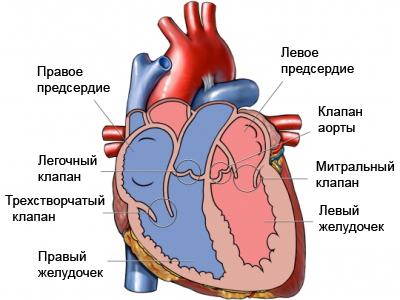Atrial septal defect
Description atrial septal defect
Atrial septal defect (DMP) It is a congenital defect. This is an anomaly in the atria (the upper chamber of the heart). When DMP wall between the left and right the camera is not completely closed.
In the developing fetus has a hole between the left and right atrium. It allows blood to bypass the lungs. When a child is born, opening, usually, closed, and the blood begins to circulate through the lungs.
Children, born with autism spectrum disorders, Blood passes from the left atrium into the right atrium. Ultimately, this can lead to problems in the lung.
PMD occurs in approximately four out 100 thousands of babies. Children with slight or moderate defects basically not suffer any form of complications or symptoms. Very small defects in the atrial septum overgrown by themselves in 90% cases. Those children, who have severe defects may become disabled in the future.

Causes of atrial septal defect
DMP is a birth defect. It means, it occurs during fetal development and is present at birth. In some cases, the disease can be caused by a genetic defect or anomaly, inherited from parents. Also, the PMD can be caused by diseases of the mother during pregnancy.
In most cases, the cause is unknown DMP.
Risk factors
Since the cause of the disease are largely unknown, there are no known risk factors for this condition.
Symptoms of atrial septal defect
Symptoms include:
- Tiredness and fatigue during physical activity;
- Sweating;
- Rapid breathing, difficulty breathing or shortness of breath;
- Chronic respiratory tract infection;
- Poor growth;
- Cardiopalmus;
- Poor appetite;
- Heart murmur.
People with small defects may have no symptoms, or they may later begin to manifest.
Diagnosis of atrial septal defect
The doctor asks about the symptoms, and medical history, and performs a physical exam. Tests may include the following:
- Chest X-ray – to take a picture of structures inside the body, especially bones;
- Echocardiogram – test, which uses high-frequency sound waves (ultrasound), to examine the size, shape and motion of the heart;
- Doppler image of the heart;
- Heart catheterization – a special tool is inserted into the heart through a vein or artery (usually in the arm or leg), to detect problems with the heart and its blood supply;
- Coronary angiography (Only patients older 35 years) – after the introduction of a radiopaque dye into the artery is performed X-ray of the blood vessel;
- Breast MRI – test, which uses magnetic waves, to make pictures of structures inside the chest;
- Electrocardiogram (ECG) – test, that records heart activity by measuring electrical current, passing through the heart muscle.
Treatment of atrial septal defect
Small defects, that almost do not cause symptoms, perhaps, did not require treatment. Besides, many defects may close on their own, without treatment. In other cases, treatment includes:
Surgery
For patients with large defects and who experience significant symptoms, Surgery may be needed.
Also, the procedure can be performed, which closes the opening without surgery. The closure device is inserted through a catheter heart, which is inserted into the groin.
Antibiotics
For six months after some surgical operations, the patient may be prescribed antibiotics before vyzitom to the dentist, or performing other procedures. In most cases, Patients should not take antibiotics before procedures.
Prevention of atrial septal defect
Since the disease – congenital defect with unknown causes of, preventive measures for it does not exist. Early diagnosis and early treatment can help prevent complications
